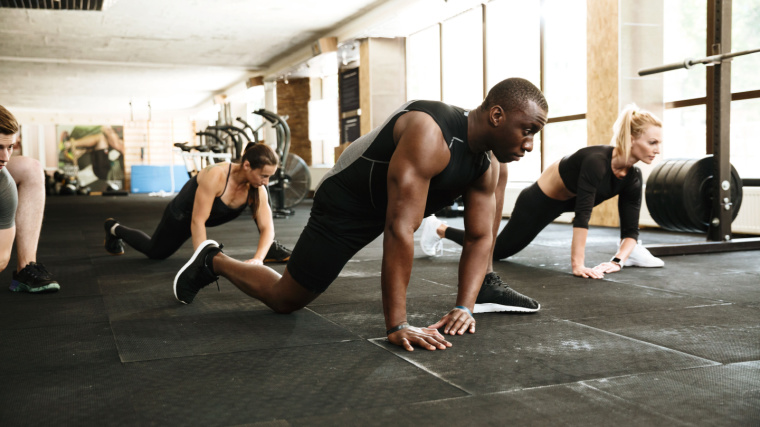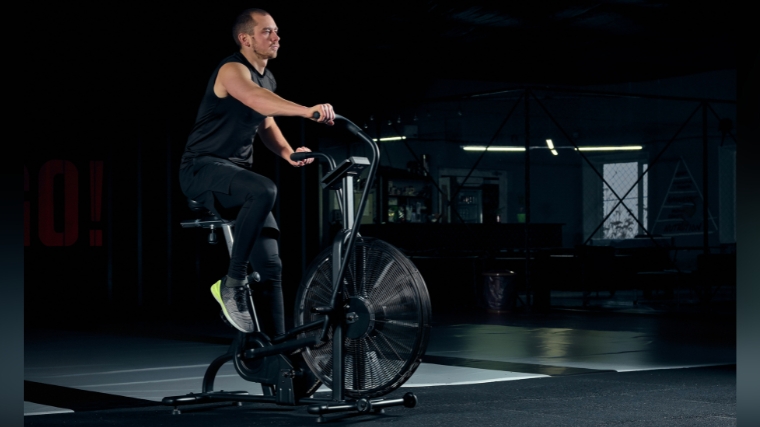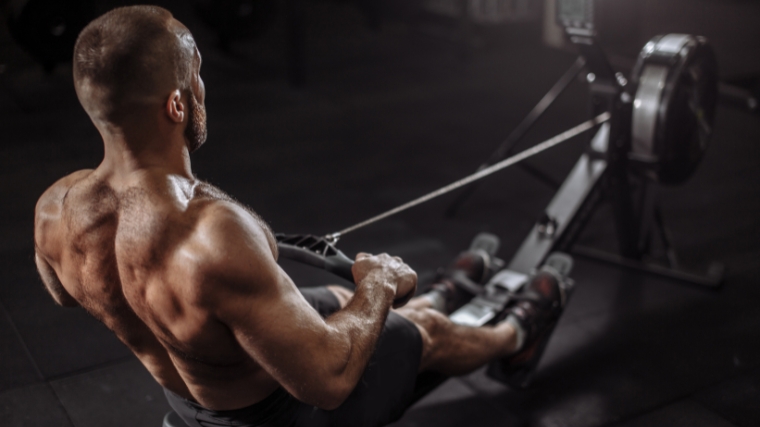CrossFit isn’t easy. The goal is to push yourself harder than you previously thought you could. You’ll be putting your body (and mind) through the gamut of heavy barbell training, intense bodyweight exercises, and a wide array of conditioning moves, ranging from box jumps and air bike sprints to sled drags and trail runs with weighted vests.
To prepare yourself for each WOD (workout of the day), it’s essential to get your brain and body into the right space. Before each CrossFit workout, a thorough warm-up is vital. To maximize your opportunity to get stronger, more muscular, and better conditioned with each workout, here is the best CrossFit warm-up — as well as how to customize it to suit your needs.

Editor’s Note: The content on BarBend is meant to be informative in nature, but it should not be taken as medical advice. When starting a new training regimen and/or diet, it is always a good idea to consult with a trusted medical professional. We are not a medical resource. The opinions and articles on this site are not intended for use as diagnosis, prevention, and/or treatment of health problems. They are not substitutes for consulting a qualified medical professional.
What Is a Warm-Up?
A warm-up is meant to elevate your body temperature while preparing your muscles, nervous system, and mind for your workout. A thorough warm-up is comprised of different components that will get your body ready for general physical activity while also getting specifically prepped for the exercises ahead.
In CrossFit, you may find yourself doing most of your WODs in the context of a class led by a coach. In that case, each class should contain a warm-up component. But you may be doing WODs on your own — or you may just want to extend the warm-up prescribed during your class.
Your warm-up is a very personal endeavor since you can (and should) use it to iron out any weaknesses or imbalances you have in your training. So even if there’s already a warm-up before your class, show up a few minutes early to squeeze in your own pre-workout prep.
Benefits of Warming Up for CrossFit
No matter which strength sport you love most, a warm-up will help you love it more. Or at least, a warm-up will help you perform better — which, in turn, will probably be something you love. Here’s why you should warm-up before your CrossFit workouts.
Mental Preparation
You might be rolling into your garage gym or CrossFit box after a long day at work, or you may be working out at the crack of dawn before your brain is even fully awake. Whatever the case may be, you’ve got to get your head in the game. A solid warm-up gives you time to shake off the rest of your day and sync into fitness attack mode.
CrossFit WODs are unique in that they are meant to be very different every day. This is very different than weightlifting, powerlifting, and even bodybuilding training sessions, which are meant to be very specific and relatively consistent.
Because CrossFit WODs are meant to be physically unpredictable, it can be very grounding to add a consistent style of warm-up. This way, you’ll give your mind a reliable signal that you’re about to get after it. This focus will serve you very well when you’re entering the so-called pain cave in the middle of a tough workout.
Potential Injury Prevention
Especially in a fast-paced, intensive sport like CrossFit, no strategy can guarantee that injuries won’t happen. However, research suggests that warming up thoroughly before strength-training sessions can significantly reduce injury risk. (1) Warming up can help stack the deck in your favor for preventing the unnecessary risk of getting hurt.
Perform at Your Highest Level
If you want to show up and execute at the highest level you can, you’ve just got to warm up. Going through a full warm-up before strength training sessions can increase your performance in big barbell lifts. (2) Especially if you’re performing ramp-up sets properly, you stand to boost your force output during big lifts, which can help you heft heavier weights more efficiently. (3)
Don’t be afraid to start breathing fairly heavily during your warm-up. Putting in that extra effort and approaching a higher intensity during your warm-up can improve your performance during your actual workout. (5) So if you start to feel the burn early on, it might actually be helpful during your WOD.
Literally Get Warmer
They don’t call it a warm-up for nothing. You are, quite literally, physically raising your temperature. But that doesn’t mean you can skip the warm-up if the weather is balmy.
Make sure your muscles are nice and toasty, too, with the blood pumping adequately to your moves. Getting physically warm before your warm-up has been shown to improve your force production and strength during your training session. (1)
How to Build a CrossFit Warm-Up
If you’re crossing into CrossFit from the powerlifting or weightlifting world, you’ll likely find a lot of overlap between typical strength training warm-ups and those for CrossFit. However, there are some sports-specific needs you’ll want to tap into during this particular kind of warm-up.
Aerobic Training
Whereas the aerobic training for non-CrossFit workouts might involve walking or even jogging, you’ll likely steer toward more CrossFit-style aerobic activities here. This doesn’t mean you can’t walk or jog for your warm-up — CrossFit does, after all, feature a lot of running (Murph, anyone?).
But in general, you’ll want to recruit muscles across your entire body during a CrossFit warm-up. This means opting for full-body cardio machines like the rower and air bike. On leg days, you may opt to choose a more traditional exercise bike to really rev up your quads while not putting any impact on your joints.
Get specific with what types of aerobic warm-ups you’re doing on each day. If your WOD is going to be pull-heavy, you might opt for rowing to wake up those back muscles. On the other hand, you might be focusing on upper body pushes. In that case, zero in on the upper body pushing component of the air bike.
Mobility Training
CrossFitters need to cultivate strong mobility training habits in order to be successful in their sport. Whether it’s handstand push-ups, kipping pull-ups, or endless overhead squats and snatches, CrossFit demands a great deal of mobility from every single joint.
Skimp on your mobility training at your own risk. Neglecting mobility exercises can easily become the difference between crushing a new PR (personal record) and staying stuck in the rut of a plateau. For best results, you’ll want to do daily mobility workouts — but integrating these moves into your warm-up is the next best thing.
Even if you do have a strict mobility practice outside of the gym, mobilizing just before your workout is key to potentially reducing your injury risk during training. (1) CrossFit WODs will always challenge your full body, but often have a specific focus.
For example, if your WOD is full of thrusters, handstand walks, or overhead squats, you’ll mobilize your ankles and hips. But you’ll need to pay special attention to your thoracic spine, shoulders, and wrists. Try wrist rolls and reverse rolls and kneeling book openers to start waking up those joints.
Muscle Activation
Once you’ve spent a few minutes focusing specifically on mobility, it’s time to combine mobility with strength. The moves you’ll do to activate your muscles will largely be bodyweight exercises that have big mobility payoffs.
For example, reverse lunges, forward lunges, and lateral lunges are all strength-building exercises that also have a tremendous payoff in terms of ankle and hip mobility.
Band pull-aparts and straight-arm lat pulldowns will build a strong upper back. They’ll also activate your lats and traps to get you ready for action. Add in some push-ups and bodyweight squats as appropriate.
Depending on your fitness level, this component of your warm-up might feel like a small workout before the big one. That’s alright. CrossFit is largely about expanding your work capacity, and that doesn’t only happen during your workout itself. Incorporating a warm-up that challenges you will help crank that work capacity up a few more notches.
Skills Training
Your WOD will likely throw a lot of different obstacles at you. In all likelihood, by the time you reach that last set of thrusters, your upper body will already be blasted by muscle-ups, handstand push-ups, or both. To ensure that you keep performing at the top of your game despite fatigue, maintaining your form is key.
To keep pushing through your reps with solid form, you need to lock down exactly how to do each move in your muscle memory. This is where skills training comes in handy. Each component of your warm-up so far has been catered toward your upcoming workout, with each aspect getting more and more specific.
[Read More: The Best Upper Body Exercises and Workouts]
Skills training is the most specific portion of your warm-up. Here, you’ll perform extremely lighter versions of the lifts of the day to dial in your technique. For example, start overhead squats and snatches with an empty barbell, a PVC pipe, or even a resistance band — ramp up the weight from there. Or, do a few jump squats, then low box jumps before gradually ramping up to the height and intensity you’ll be using during your WOD.
Best CrossFit Warm-Up
First things first: there isn’t just one way to warm up for a WOD. That said, this CrossFit warm-up will set you up for success by touching on every component you need to become the best functional fitness athlete you can be.
Aerobic Training
- Air Bike: 3-5 minutes, low intensity*
* If you’re going to perform an upper body-focused WOD, pedal only with your arms for the last minute or two of your aerobic warm-up.
Mobility Training
- Active Frog Stretch: 60 seconds
- Band Pull-Apart: 15-20
- Bodyweight Single-Leg Romanian Deadlift: 10 per side
- Bottoms-Up Squat: 10
- World’s Greatest Stretch: 6 per side
Muscle Activation
- Push-Up: 10
- Reverse Lunge: 10 per side
- Lateral Lunge: 10 per side
- Bottom Squat Rotation: 6 per side
- Beast Crawl: 10
- Pull-Up: 10**
** Use assistance bands if you need to.
Skills Training
- Main Strength Move of the Day: 10 reps***, empty bar, resistance band, or bodyweight
- Secondary Strength Move of the Day: 10 reps***, empty bar, resistance band, or bodyweight
- Ramp-Up: For each big strength move, gradually add weight to the bar (or use heavier kettlebells or dumbbells) until you can perform two to three reps with 75 percent of your WOD working weight.
*** If your main or secondary strength moves are particularly challenging and doing 10 reps will tax you too much, perform fewer reps as needed. For example, only perform two or three muscle-ups instead of 10 if needed.
You can modify this warm-up to suit your needs by plugging in slightly different movements as needed. For example, if you don’t have access to an air bike, swap in a rower instead. For each of the four prongs of the warm-up, you can swap out any of the exercises for a similar move that suits your needs a bit better. You’ll learn exactly how to do that below.
How to Customize Your CrossFit Warm-Up
As you gain more experience as an athlete, you’ll likely develop a specific warm-up routine that you use across the board before your workouts. These will likely take into account your personal weaknesses in the gym — for example, you might have poor shoulder mobility that needs addressing daily.
You may also look forward to a specific mode of aerobic training before your workout. If you’re prone to skipping your warm-up, it may be best to use movements you know you’ll want to do — better a general warm-up than none at all.
To customize your warm-up to each WOD, consider the following factors:
- What mobility or strength shortcomings do you have that need to be addressed?
- Which muscle groups will get most fatigued during your workout?
- Which joints will be under the most amount of strain during your workout?
- What specific exercises do you need to ramp up for before starting your WOD?
- Are there any exercises that I know from past experience make me feel extra energized or focused for a workout?
Select one to three movements to answer each of the above questions. As appropriate, plug them into the components of your warm-up — aerobic training, mobility training, muscle activation, and skills training — and you’ve got yourself a warm-up.
Don’t Start Cold
If you like the sport of CrossFit, you likely find yourself seeking ways to perform better in your box. Supplementing your day-to-day training with warm-ups is, plain and simple, one of the most accessible ways to improve your CrossFit game. Warming up for CrossFit training sessions will prep your body for greatness — which is likely to be exactly what you’re chasing.
References
- Fradkin AJ, Gabbe BJ, Cameron PA. Does warming up prevent injury in sport? The evidence from randomised controlled trials? J Sci Med Sport. 2006 Jun;9(3):214-20.
- Fradkin AJ, Zazryn TR, Smoliga JM. Effects of warming-up on physical performance: a systematic review with meta-analysis. J Strength Cond Res. 2010 Jan;24(1):140-8.
- Ribeiro B, Pereira A, Neves PP, Sousa AC, Ferraz R, Marques MC, Marinho DA, Neiva HP. The Role of Specific Warm-up during Bench Press and Squat Exercises: A Novel Approach. Int J Environ Res Public Health. 2020 Sep 22;17(18):6882.
- Abad CC, Prado ML, Ugrinowitsch C, Tricoli V, Barroso R. Combination of general and specific warm-ups improves leg-press one repetition maximum compared with specific warm-up in trained individuals. J Strength Cond Res. 2011 Aug;25(8):2242-5.
Featured Image: Dean Drobot / Shutterstock



